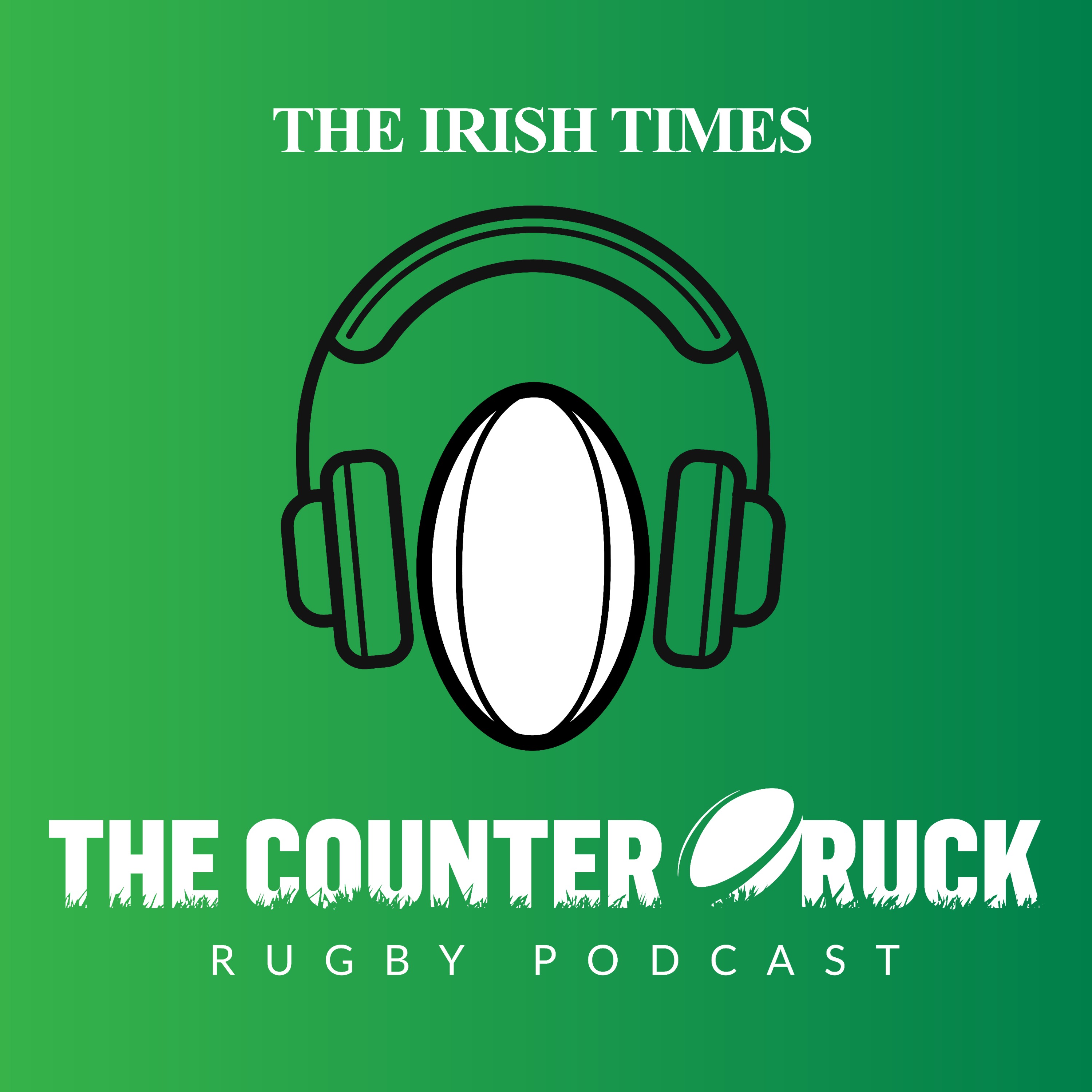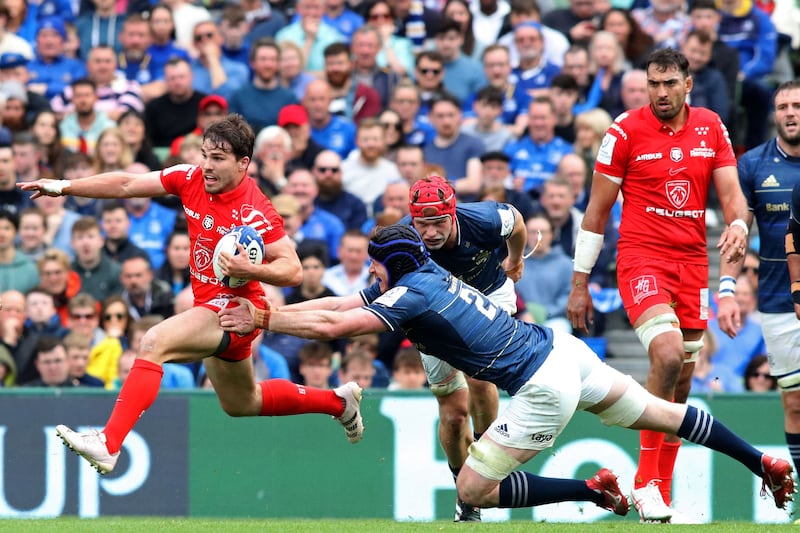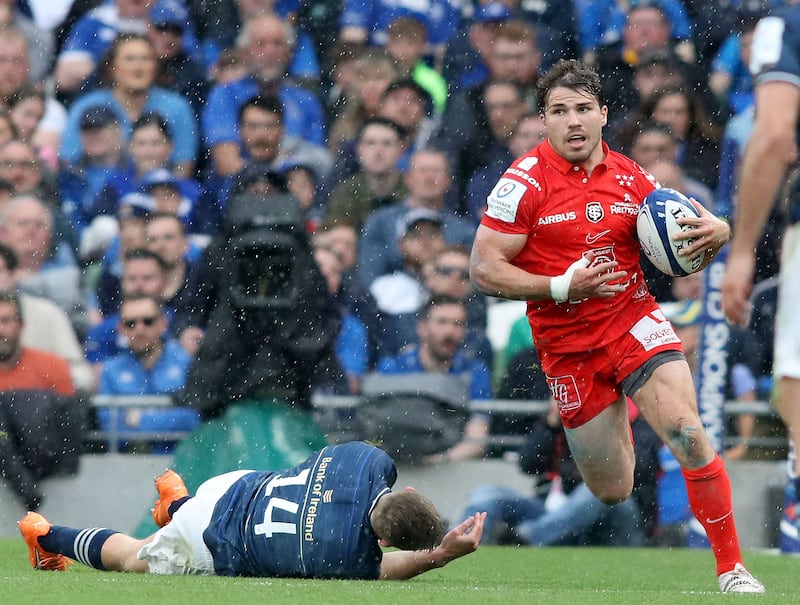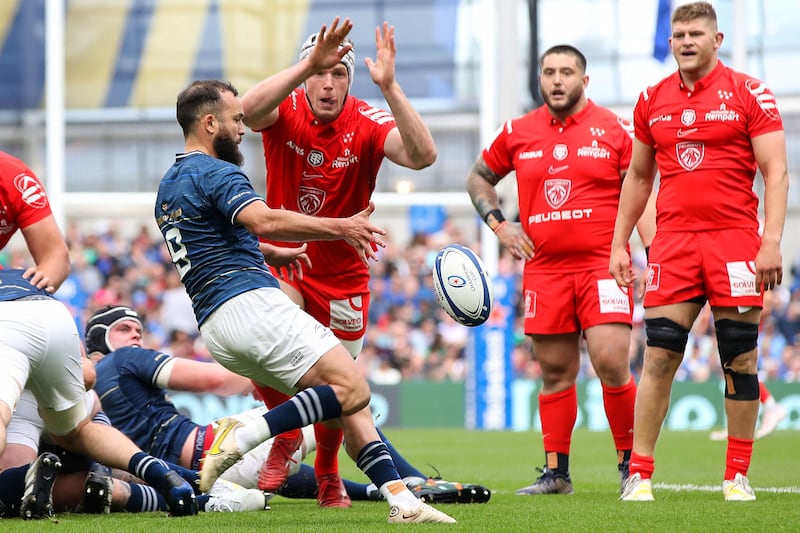On Saturday at the Tottenham Hotspur Stadium two titans in the nine jersey, Leinster’s Jamison Gibson-Park and Toulouse’s Antoine Dupont, will square off. The word “influencer” has become part of the universal lexicon in today’s culture and it could surely apply to both of these players given the direct impact they have on their respective teams, not only in style but in substance.
Dupont is generally nicknamed “Toto” but France and Toulouse prop Cyril Baille calls him “the Martian”, on the grounds that his team-mate is a player “who comes from another planet”. It can certainly appear that way given his prodigious talent, more so perhaps to the opposition, who are often left spellbound by his wizardry.
New Zealand’s Aaron Smith, once considered to be the best scrumhalf in world rugby, formally abdicated that title several years ago, and in handing it over to Dupont he said: “He is the point of difference for both his club and country. He’s helping me look at parts of my game to improve.”
Gibson-Park has also attracted glowing testimonials. Team-mate James Lowe ventured after the scrumhalf’s performance in the semi-final win over the Northampton Saints that “there’s a reason why Jamison’s probably the best nine in the world”. Former All Black scrumhalf TJ Perenara has said: “He [Gibson-Park] was one of the most gifted players I ever played with. I mean everything that guy touches often turns to gold.”
READ MORE

Zebo retires, Keenan to the Olympics and Leinster's Champions Cup showdown
Namechecked by team-mates and opponents, the pair are regularly mentioned in any conversation about the pinnacle of scrumhalf play. Former Wales and Lions captain Sam Warburton declared: “If Antoine Dupont wasn’t on this planet, then we’d be saying this guy’s [Gibson-Park] the best number nine in the world by a mile.”
While they share several qualities, including work-rate, running lines, support play, a pinpoint kicking game and a predator’s instincts to sniff out opportunity, they vary in how they operate within team parameters. That’s as much down to the way that Toulouse and Leinster differ in their attacking set-up and patterns.

Dupont likes to take the game on in a carrying capacity while Gibson-Park prefers to control pace and direction; they’re both brilliant at what they do and it’s hardly a surprise they’re both on the shortlist for European player of the year.
Dupont missed the Six Nations so that he could lay the groundwork for a temporary switch to Sevens. He played two tournaments on the World Series and in Los Angeles helped France to a first title in 19 years. After the Champions Cup, he’ll return to the Sevens enclave to prepare for the Paris Olympics.
The 27-year-old adapted superbly to a version of the sport he’d last played over a decade ago as a teenager, including grabbing a winning try against Ireland in Vancouver. When he returned, fresh and invigorated, to Toulouse colours in the French Top 14, he immediately re-asserted his majesty, one 60-metre break against Bordeaux offering a reminder of his perennial excellence.
He looks leaner, fitter and faster – it is a prerequisite of Sevens to have superior aerobic conditioning. That is pretty ominous for Leinster.

Even by his astronomical standards his numbers in this season’s Champions Cup are hugely impressive and represent the diverse brilliance of his contribution.
He is joint third in the try-scoring stakes – alongside two team-mates, wing Mathis Lebel and hooker Peato Mauvaka – but thereafter no player features more prominently across sundry categories. Dupont has carried more ball (110) than any other player in the tournament – Leinster number eight Caelan Doris (90) features in the top five – which is unheard of for a scrumhalf. The remainder are back-three players.
He has made more offloads (20) than anyone, and is second in clean breaks (13), metres made (534) and passes (374). He is the only back to feature in turnovers won (nine) alongside Will Evans, Courtney Lawes, Tadhg Beirne and Levani Botia.
What do such statistics mean in terms of game play? Leinster can’t afford to take their eye off him for a nanosecond; they have managed to keep tabs on him pretty well in recent times, as Dupont has finished on the losing side in the last four matches against either Leinster or Ireland.
Munster were also effective in largely curtailing his influence in the 2022 quarter-final that Toulouse won on a penalty shoot-out, harassing and scragging him at every breakdown, counter-rucking aggressively.
Leinster received a valuable lesson in the semi-final win at Croke Park as Northampton and England scrumhalf Alex Mitchell found a few gaps in the fringe defence. If those holes are there for Dupont on Saturday, he’ll ruthlessly exploit them.
His squat power, acceleration, vision, ability to get second and third touches in a sequence of play – and to create space for others – make him a nightmare to try to chaperone on a pitch. Those nine turnovers at the breakdown underline the threat he will pose to any under-resourced Leinster rucks.
Gibson-Park’s figures may be more modest, but his influence is certainly comparable. He has accepted the role of focal point of Leinster creativity, one previously discharged by Johnny Sexton. Five tries, six clean breaks, 12 defenders beaten, six offloads, six try assists and four turnovers are excellent numbers relative to anyone other than Dupont in European competition this season.

The only category in which he surpasses the Frenchman is passes made (493 to 374). That highlights Gibson-Park’s role within his team. When Leinster manage quick, front-foot ball, he becomes the attacking hub. His vision, decision-making and execution set him apart. The perfectly flighted and weighted pass to pick out Lowe between two Northampton players in the semi-final was a thing of beauty.
His coverage of the backfield is first class, as he is alive to danger and quick enough to snuff it. And his support lines, like Dupont’s, are intuitively sharp. Gibson-Park will need his team-mates to take some of the load off him: Leinster’s backline attack has looked unusually clunky at times, the timing and accuracy of passing not where they need to be.
In that respect Dupont is not overburdened, there are plenty of others who can set the attacking tempo in the Toulouse team, more so than their opponents, who rely more on shape.
Leinster will focus on negating the platforms that allow Dupont to be a threat: quick ball, gaps on the fringes, brittle tackling as much as directly chasing after or trying to curb le petit général génial. The blueprint is there from previous semi-finals, albeit there’s no chance a simple cut and paste will suffice.
Toulouse will look to disrupt Leinster’s possession-heavy game, stop them on the gain-line, slow ball down, force them to kick more, all of which will reduce Gibson-Park’s capacity to affect the game in the manner to which he is accustomed.
It’s the contest within a contest between two scrumhalves at the peak of their powers, each with the talent to break open matches, bend games to their will. It’ll be a fascinating watch.
- Sign up for push alerts and have the best news, analysis and comment delivered directly to your phone
- Join The Irish Times on WhatsApp and stay up to date
- Listen to our Inside Politics podcast for the best political chat and analysis


















